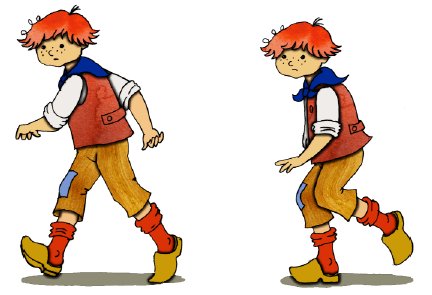Imagine Internships
Sketch-based modeling of animated characters.

Advisors
Marie-Paule Cani, IMAGINE team, LJK-INRIA, GrenobleAlla Sheffer, UBC Vancouver
Contact: marie-paule.cani@inrialpes.fr
Context and objectives
When creating an animation film, artists currently have to choose between either 3D modeling and animation of their characters - a tedious process, which also limits the range of possible motions and deformations - or the direct sketching of their animation in 2D, on a series of animation layers. While offering more freedom to the artists, this traditional technique did not change much with the digital age: the quality of shapes and motion still entierly rely on the artists knowledge and skills, and its use if difficult for beginners.
The goal of this project is to explore how knowledge on the 3D structure of a character (such as the fact that its skeleton is symetric with respect to a spine curve), could ease the modeling and animation of 2D cartoon characters. For instance, it could provide automatic construction lines to help re-drawing the character in a different posture or from a different viewpoint. It could also be used to improve in-betweening between key-frames.
Work to be done
The main idea is to inspire from sketch-based modelling [1] and from 3D skinning techniques [2] to deform the cartoon drawing as if it was skinning a 3D skeleton. More precisely, the main issues to be solved are:
-
Reconstructing a 3D skeleton from a cartoon drawing of a character and some a priori knowledge on the symetrical and hierarchical nature of the skeleton.
-
Providing guide-lines during the sketching of the next frame, from real-time inferrence of the new posture of the skeleton, and its use to deform the contours of the initial sketch. Here, reconstructing a rough volume for the character around the 3D skeleton may be needed, to express the fact that the limb contours are typically non-flat silhouettes of this volume.
-
Combining knowledge on the skeleton animation and on the sketches to develop some plausible, automatic in-betweening for both contours and textured regions in the drawing.
Validation will be done by comparing the results with those of purely 2D deformation and texturing techniques, such as [3,4].
References
[1] Matisse: Painting 2D regions for Modeling Free-Form Shapes. Bernhardt Adrien, Pihuit Adeline, Cani Marie-Paule, Barthe Loic. In Alvarado C. et Cani M.-P. editors, /EUROGRAPHICS Workshop on Sketch-Based Interfaces and Modeling, SBIM 2008/. Annecy, France, juin 2008. p.57-64 2008.[2] Exact volume preserving skinning with shape control. Rohmer Damien, Hahmann Stefanie, Cani Marie-Paule. In Symposium on Computer Animation, SCA '09: "Moving Research"/. Eurographics/ACM SIGGRAPH, New Orleans, Etats-Unis, aout 2009. pages 83-92. ACM, 2009.
[3] As-Killing-As-Possible Vector Fields for Planar Deformation. Justin Solomon, Mirela Ben-Chen, Adrian Butscher, and Leonidas Guibas. Computer Graphics Forum, 30(5), 2011.
[4] TexToons: Practical Texture Mapping for Hand-drawn Cartoon Animations. Daniel Sykora, Mirela Ben-Chen, Martin Cadik, Brian Whited and Maryann Simmons, Proceedings of the International Symposium on Non-Photorealistic Animation and Rendering, (Best Paper Award), 2011.
